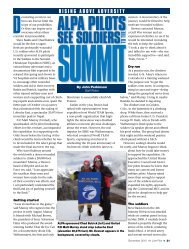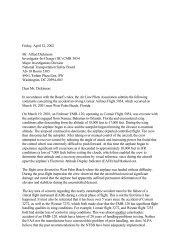By Jan W. Steenblik, Technical Editor - Air Line Pilots Association
By Jan W. Steenblik, Technical Editor - Air Line Pilots Association
By Jan W. Steenblik, Technical Editor - Air Line Pilots Association
You also want an ePaper? Increase the reach of your titles
YUMPU automatically turns print PDFs into web optimized ePapers that Google loves.
Yeager’s folksy West Virginia drawl drifted down from the<br />
high desert to airline cockpits everywhere, the rest of the<br />
book is spot-on. Oh, the egos, the competition, the fear of<br />
being left behind that the righteous True Brothers, those<br />
imbued with The Right Stuff, shared!<br />
And the dangers: Peacetime military flying alone offered a<br />
pilot “more ways to get himself killed than his wife and children<br />
could imagine,” and the test pilots pushing the envelope<br />
in the first rocket-powered airplanes faced even more risks.<br />
When the manned “space race” began, the True Brothers<br />
debated whether astronauts would be just “spam in a can,”<br />
and if applying for the Mercury program would sideline<br />
one’s career. They found public and news media adoration of<br />
the Seven, especially of John Glenn after his first U.S. orbital<br />
flight—New York City cops crying openly in the street!—<br />
initially baffling.<br />
“The difference between pilot and passenger in any flying<br />
craft came down to one point: control,” Wolfe writes. Well,<br />
yes! The Seven insisted on, and were given, a window, a<br />
hatch, and manual control.<br />
But after Gus Grissom “screwed the pooch” and lost the<br />
capsule in the Atlantic, “The True Brothers were incredulous…the<br />
Mercury astronauts had an official immunity<br />
to three-fourths of the things by which test pilots were<br />
ordinarily judged. They were by<br />
Reviews Wanted now ablaze with the supersti-<br />
Want to submit your own book tious aura of the single-combat<br />
review? Send it to magazine@ warrior [an ancient tradition<br />
alpa.org. We’ll post it on www. in which a battle between two<br />
alpa.org/bookshelf.<br />
warriors determines the outcome<br />
of a war between clashing<br />
armies]. They were the heroes of Kennedy’s political comeback,<br />
the updated new frontier whose symbol was a voyage<br />
to the moon.”<br />
Back at Edwards, test pilots Walker, White, Crossfield, and<br />
Yeager “had already ridden rockets from the X-1 to the X-15.<br />
And they had ridden them as pilots.” And: “People were<br />
impressed because the Mercury astronauts were willing to<br />
risk having Redstone rockets blow up under them. Christ!<br />
Rockets had already blown up under good men!”<br />
Some of that flying at Edwards is vividly described—including<br />
Yeager’s flight above 100,000 feet in the NF-104, which<br />
was an F-104 (an unforgiving beast) fitted with an auxiliary<br />
rocket engine. Yeager lost control of the NF-104 and ejected,<br />
then was badly burned on the face and hand by molten metal<br />
from the falling ejection seat—so badly that the teenager who<br />
found him in the desert puked. Yeager recovered and went on<br />
to fly 100 B-57 missions in Southeast Asia.<br />
Wolfe’s ability to get inside people’s heads and get it all on<br />
paper is amazing; The Right Stuff is hard to put down.<br />
On Quiet Wings: A Soaring Anthology,<br />
edited by Joseph Colville Lincoln, offers a superb sampling<br />
of writing about gliding and soaring. This coffee-table-size<br />
book is beautifully laid out and profusely illustrated with<br />
great photos and drawings.<br />
From the preface: “The great moments in soaring are won<br />
by men [and women who]…have known the terrors of rotor<br />
cloud, the crash of hail on metal,<br />
the growing of ice on leading<br />
edges and canopy, the near flash<br />
of lightning under a black overcast;<br />
or the agony of staying aloft<br />
in zero sink, a few hundred feet<br />
over brutal terrain while the sweat<br />
runs and nerves pull taut.… They<br />
have also known the exaltation of<br />
the heights when, shivering from<br />
cold, with a heavy pull of oxygen through their mask, they<br />
have seen range after range of mountains growing fainter<br />
blue with distance, and over them blazing cumulus clouds<br />
towering toward heaven….”<br />
Lincoln culled most of the contents from 33 years of<br />
Soaring, the monthly magazine of the Soaring Society of<br />
America. On Quiet Wings covers much ground—mythology;<br />
early history; the adaptations of soaring birds; training, troop,<br />
and cargo gliders in World War II; cross-country flying; record<br />
flying; contest soaring; accidents; and mountain wave flying.<br />
Published in 1972, On Quiet Wings is dated: Today’s glass<br />
superships boast max glide ratios exceeding 50:1, and race<br />
and record attempts are saved on GPS recorders. The soaring<br />
altitude record is now 50,721 feet; the distance record, 1,217<br />
nm. But the book remains a classic, and every glider pilot<br />
should own a copy; so should every power pilot who’s ever<br />
wondered what it’s like to climb on quiet wings.<br />
The Twenty-One Balloons, written and<br />
illustrated by William Pène du Bois,<br />
received the John Newbery Medal for<br />
children’s literature in 1948.<br />
The plot: A retired San Francisco<br />
schoolteacher plans to spend a year<br />
aloft in a one-room cabin suspended<br />
beneath a huge hydrogen balloon. He<br />
launches on Aug. 15, 1883. A week<br />
later, he suffers a bird strike (the plot<br />
device is credible!) and lands on a<br />
tropic isle—Krakatoa, dominated by the volcano that actually<br />
erupted explosively on Aug. 27, 1883.<br />
Twenty families secretly inhabit the interior of the island.<br />
They periodically sail away to sell diamonds from an extraordinary<br />
mine at the base of the volcano and to replenish their<br />
supplies. When the volcano acts up, the families and their<br />
guest escape on a giant platform buoyed by 20 balloons.<br />
The novel is a delightful piece of whimsy, offering such<br />
marvelous inventions as a 20-day culinary calendar: On<br />
the first day of the month, everyone eats at the “A” family’s<br />
American restaurant. The next day, they eat at the “B” family’s<br />
British chop house, and so on. The children pilot a balloon<br />
merry-go-round that launches as eight linked balloons<br />
and, after landing at sea, converts to eight small sailboats.<br />
The book takes license with meteorology, geology, and<br />
history, and ignores the grim results of history’s greatest<br />
volcanic eruption—40,000 or more dead, and a 5-year miniice<br />
age in Europe. But, after all, this is a novel for children.<br />
Enjoy it yourself, then give it to a young reader.<br />
December 2010 <strong>Air</strong> <strong>Line</strong> Pilot 35





